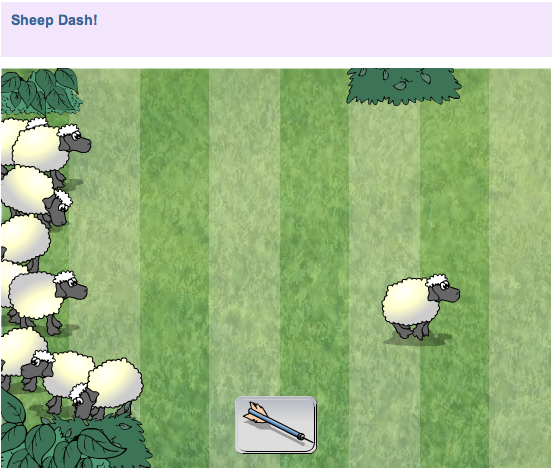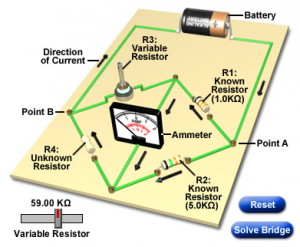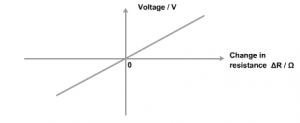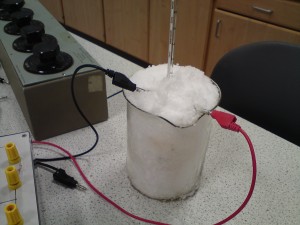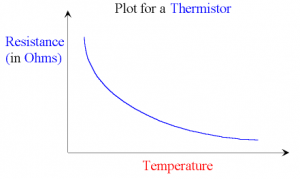 mrmackenzie
mrmackenzie
measuring reaction time
We measured people’s reaction time in class today using this BBC site. Click on the picture to try again at home.
It is important to consider reactions when we measure short times. In Physics, we often try to avoid reaction times affecting our results by using data loggers and light gates to take accurate time measurements.
Read about using light gates to measure average speed and instantaneous speed on pages 6 & 8 of your Transport booklets.
the wheatstone bridge
We’ve just completed the section of Higher unit 2 that investigates the behaviour of a Wheatstone Bridge. The bridge circuit is really just a pair of voltage dividers connected in parallel. A voltmeter, ammeter or galvanometer (very sensitive ammeter) connects the two voltage divider chains together, as shown below.
When the voltage (or current) displayed on the meter is zero, we say that the Wheatstone bridge is balanced. For a balanced bridge, it is possible to show that
[you have this proof in your notes folder]
For the circuit shown above, the voltmeter will display the difference in electrical potential between points B and D. We can calculate this potential difference by finding the voltages at points B and D using the voltage divider equation you used for National5/Standard Grade/Intermediate 2 Physics.
So in this example,
and
The voltmeter displays the potential difference between these two points, i.e.
Here is a short video that provides a recap of the Wheatstone Bridge.
and a worked example from an old SQA past paper
Now click on the picture below to try an interactive Wheatstone Bridge problem (you will need to have Java installed).
Instructions:
- Press the Reset button to change the value of all the resistors in the circuit.
- Use the slider to balance the bridge. The circuit uses a centre-zero meter, so aim to get the indicator dead centre.
- Find the unknown resistance (R4) using the value of the other 3 resistors when the circuit is balanced.
You can repeat this simulation as many times as you like by pressing Reset to change the resistor values…..it’s great practice!
Here is an example of an application of the Wheatstone Bridge, called the metre bridge.
When a Wheatstone Bridge is slightly out of balance, it will provide a linear response. In other words, small changes in resistance will produce proportionally small changes in voltage or current. When these small changes are plotted, we obtain a straight line through the origin, like this:
We tried to use this property of a Wheatstone Bridge to find the temperature of the physics classroom. We used some of the snow outside for a low temperature and boiling water for a high temperature.
As we discussed today, this was not a particularly successful experiment due to the non-linear response of the thermistor to changes in temperature – you might remember this from Standard Grade or Int 2 Physics.
For temperature ranges much smaller than the 100°C we attempted, it is possible to obtain an accurate estimate of room temperature.
Click on the download link below to try some Wheatstone Bridge questions.
S3 snow day work
I have uploaded a set of notes on the Using Electricity unit. Please click on the download link below and save a copy on your computer at home. I would like everyone to read up to the end of page 19. This will cover everything that we have looked at so far on this topic.
Please try to answer as many of the questions in these notes as you can, either by printing out the pages and writing in the spaces or using your Physics jotter.
You may leave a comment if you get stuck with anything and I will try to help.
5.3 snow day work – past paper questions
We worked on some past paper questions today and I would like you to try these at home if you were unable to make it to school.
The attached pdf file contains 2 past paper questions. The first question is Q24 from the 2008 paper, the second is Q25 from 2007. Please attempt both questions. If you get stuck, leave a comment on this post and I will get back to you. Next time you are in school I will hand out copies of the specimen solutions for you to check your progress.
5.5 snow day work – past paper questions
We only had 6 people in class today due to lack of school buses. Those who made it in asked to do revision questions, so we worked through the 2010 Higher paper. If you couldn’t get in today, please download the paper by clicking on the link below.
I would like you to attempt the following questions;
- Q24 (all)
- Q25 part (a) only
- Q26 parts (a) & (b) only
- Q27 (all)
- Q28 (all)
This will cover a good section of the unit 3 work you have been looking at with Mrs. Sutherland as well as the unit 2 material you have covered in my class. Remember you have booklets with worked solutions but please only use once you have finished or are stuck and can’t get any further without help.
Add a comment to this post if you have any questions.
snow day work for S4
If you can’t get to school due to the weather, here is some work for you to do at home. We will start the Transport topic when we have finished our Investigations. Please use these notes to begin looking at the Transport unit.
Read the notes on average and instantaneous speed and try the questions. If you have a printer at home, please also try to print out the pages with squared sections to practice drawing speed-time graphs.
Click on the download link below to get the file – you will need Adobe Acrobat Reader.
higher snow day work – part 2
The weather forecast says we could be in for loads of snow later this week so I have uploaded some more work for you to do if you can’t get in to school or we end up having to close. Please continue to work through the unit 2 notes I uploaded last week but these unit 1 notes are worth looking at if you have finished the 2nd unit. You may not be able to answer all of the questions (such as the acceleration section) without some experimental results but just move on to the next section instead.
If you have any questions, just post a comment and I will get back to you.
Snow day work for Higher Physics
I have attached a link for you to download some notes on Unit 2 of the Higher course. Both Higher sets will be able work up to page 15, covering work we have already looked at in class.
5.3 should then work through pages 18 & 19 in preparation for the next section of unit 2. You have new homework – see the entry further down this page.
5.5 – you can also work through the Wheatstone Bridge activities on pages 20-25.

